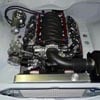Radiator: Is Aluminium Better Than Copper?
#1
 _LHoon_
_LHoon_
Posted 30 April 2008 - 04:24 PM
Is this a myth?
Are aluminium radiators just for looks?
I checked the thermal conductivity of the two, and copper wins by far.
Copper = 401 W�m−1�K−1
Aluminium = 237 W�m−1�K−1
Can someone shed some light on this topic?
#2

Posted 30 April 2008 - 04:57 PM
#3
 _Herne_
_Herne_
Posted 30 April 2008 - 05:04 PM
Copper one of course can be readily repaired almost anywhere.
One tip I saw recently on one of the American Hot Rod type shows was that they used a copper radiator but made up an alloy surround that bolts on to dress it up. Something I am going to look into as I want the alloy look.
Edit: Standard top and bottom tanks were use, the alloy shroud just hid them and dressed them up.
Cheers
Herne
Edited by Herne, 30 April 2008 - 05:10 PM.
#4
 _1uzbt1_
_1uzbt1_
Posted 30 April 2008 - 06:56 PM
Ally cant be repaired easily,the tube are just to thin to try and weld,but there are alternatives to do repairs.Generally if ally starts leaking in the core,its pretty muched stuffed.
Edited by 1uzbt1, 30 April 2008 - 06:56 PM.
#5

Posted 30 April 2008 - 09:30 PM
http://www.stockcarp...ts.com/rad2.htm
It was posted by ALX76 in this thread.
http://www.gmh-toran...showtopic=13789
#6

Posted 30 April 2008 - 09:46 PM
READ THIS
Aluminum vs. Copper/Brass Radiators
Copper is a better conductor of heat than aluminum. Copper/brass radiators usually have copper fins, but brass tubes (70% copper, 30% zinc). The bond between the fins and the tubes may be made with soldier (A tin/lead alloy, or high-tin alloy) or with a braze material (mostly copper).
#7
 _Herne_
_Herne_
Posted 30 April 2008 - 10:44 PM
From Wikipedia, the free encyclopedia
"A solder is a fusible metal alloy with a melting point or melting range of 90 to 450 �C (200 to 840 �F), used in a process called soldering where it is melted to join metallic surfaces. It is especially useful in electronics and plumbing. Alloys that melt between 180 and 190 �C are the most commonly used.
The word solder comes from the Middle English word soudur, via Old French solduree and soulder, from the Latin solidare, meaning '�to make solid�'. In North America "solder" is pronounced with a silent L. Solder can contain lead and or flux but in most cases solder is now lead free"
Of course it could always be a typo but I have seen many instances where it is written as soldier which makes me wonder.
Having said that it appears to be an interesting article and clearly worth of someone like DA. As for me I prefer it dulled down a little
Cheers
Herne
Edited by Herne, 30 April 2008 - 10:45 PM.
#8

Posted 30 April 2008 - 11:15 PM
Copper is a good heat conductor, but solder required to bond the tubes to fin creates an insulation point that prevents some heat transfer. Aluminum tubes are welded rather than soldered to the aluminum tanks, providing a more efficient conductor for cooling efficiency.
The strength of the materials is one difference between aluminum and copper. The copper tubes carrying the coolant must be very thin to keep a copper brass radiator cooling efficiently. Since copper is relatively weak, the tubes must be narrow in order to prevent the internal pressure from swelling or exploding. Aluminum is much stronger, allowing the use of considerably wider tubes. Wider tubes allow more direct contact between the fins and the tube, increasing the radiator�s capacity to dissipate heat away from the engine.
#9
 _LHoon_
_LHoon_
Posted 01 May 2008 - 09:46 AM
After reading ALL of the information contained above and in the links, there is no doubt whatsoever. A good quality aluminium radiator is the way to go!!
That info is really helpful. Thanks!
#10

Posted 01 May 2008 - 12:19 PM
Aluminium cored radiators cool much better than copper/brass radiators. But, the copper/brass ones last longer, especially if you don't watch your coolant mix.
Take a look at Commodore V6s, the standard thin aluminium radiator has no trouble, even towing with a/con on, during summer.
I had a customer who purchased a 2nd hand VR V6 which had the old aluminium radiator corroded away. Not repairable, just buy a new one, He had the choice between the aluminium & an aftermarket copper/brass one. He bought the copper/brass one. On a hot day (under load, towing a trailer) on the freeway at 100km/h, it consistantly ran hot. He swapped it for a new aluminium one (which has a thinner core, by the way) & problem solved. I've seen this issue with taxis also.
Dr Terry
#11

Posted 01 May 2008 - 01:55 PM
Now THATS funny !!!!.......it appears to be an interesting article and clearly worthy of someone like DA..........
#12
 _1uzbt1_
_1uzbt1_
Posted 01 May 2008 - 03:13 PM
Copper/brass have external corrosion problems far more than any ally rad,if they arent kept painted or are in high corrosive environments(near the beach)they will die in no time.
Ally on the other hand suffers more readily from internal corrosion(mixed coolants,stray current,bad installation)and cant be easily fixed.If installed and maintained correctly they will last just as long as a copper/brass one,im am still replacing original rads out of vn/vp model commodres.
#13
 _LHoon_
_LHoon_
Posted 08 May 2008 - 01:37 PM
#14

Posted 08 May 2008 - 02:10 PM
if your core is wider than it is high go with tanks on the sideIf you have plenty of space available for the radiator, is there any technical benefits from having the tanks on the sides rather than the top/bottom... or visa versa?
if your core is taller than it is wide go with tanks top and bottom.
its all to do with packaging
#15

Posted 08 May 2008 - 02:14 PM
If you have plenty of space available for the radiator, is there any technical benefits from having the tanks on the sides rather than the top/bottom... or visa versa?
Yes, a cross flow radiator (tanks on the side) usually has the cap located on the outlet side, there for the cap is not exposed to the violent water coming out of the motor which can sometimes force the cap off its seat momentarily causing a slight loss of pressure/water which will raise the temp. This can not be avoided in a conventional radiator but the cap is usually not located directly above the inlet pipe coming from the motor for this reason.
Edited by ALX76, 08 May 2008 - 02:15 PM.
#16
 _MAWLER_
_MAWLER_
Posted 08 May 2008 - 06:07 PM
#17
 _rorym_
_rorym_
Posted 08 May 2008 - 08:07 PM
Cool...This explains my alloy radiator perfectly..ALX you are a wealth of info.If you have plenty of space available for the radiator, is there any technical benefits from having the tanks on the sides rather than the top/bottom... or visa versa?
Yes, a cross flow radiator (tanks on the side) usually has the cap located on the outlet side, there for the cap is not exposed to the violent water coming out of the motor which can sometimes force the cap off its seat momentarily causing a slight loss of pressure/water which will raise the temp. This can not be avoided in a conventional radiator but the cap is usually not located directly above the inlet pipe coming from the motor for this reason.
R
#18
 _the gts_
_the gts_
Posted 09 May 2008 - 03:53 AM
With the stray current do alloy ones get mounted on rubber mounts normally?
#19
 _1uzbt1_
_1uzbt1_
Posted 09 May 2008 - 10:28 AM
Yes.Solid mount can lead to a better path to ground increasing straycurrent reading.With the stray current do alloy ones get mounted on rubber mounts normally?
#20

Posted 09 May 2008 - 10:43 AM
Yes, cross flow is the superior technology in this respect, conventional radiators design is a carry over from the day when cars had no water pump.So cross flows are better or is it just as good to have the cap on the opposite side of the hose?
It is most preferable to have the cap on a conventional radiator as far away from the motor discharge point as possible.
#21
 _rorym_
_rorym_
Posted 09 May 2008 - 11:58 AM
I used ..FJ Holden mounts...rubber centre with the bolts moulded onto each end.Yes.Solid mount can lead to a better path to ground increasing straycurrent reading.
With the stray current do alloy ones get mounted on rubber mounts normally?
R
https://rsp-secure.c...pg&ImageFolder=
Edited by rorym, 09 May 2008 - 12:03 PM.
#22

Posted 09 May 2008 - 12:38 PM
Most aftermarket alloy radiators are bolted in the same as a standard Torana radiator.With the stray current do alloy ones get mounted on rubber mounts normally?
I think the factory radiators are rubber mounted because it is quicker on the assembly line to drop a radiator in rather than bolt it in.
#23
 _LHoon_
_LHoon_
Posted 09 May 2008 - 02:11 PM
I just read somewhere on the net that said it is best to have the tubes as long as possible. So if your radiator is wider than it is tall, then cross flow is better. If your radiator is taller than it is wide, then top/bottom tanks are better.Yes, cross flow is the superior technology in this respect, conventional radiators design is a carry over from the day when cars had no water pump.
Don't know why this would be any better though. The total surface area of the tubes would be the same for both cases.
#24

Posted 09 May 2008 - 02:24 PM
#25
 _1uzbt1_
_1uzbt1_
Posted 09 May 2008 - 02:51 PM
Just an idea anyway.
1 user(s) are reading this topic
0 members, 1 guests, 0 anonymous users















